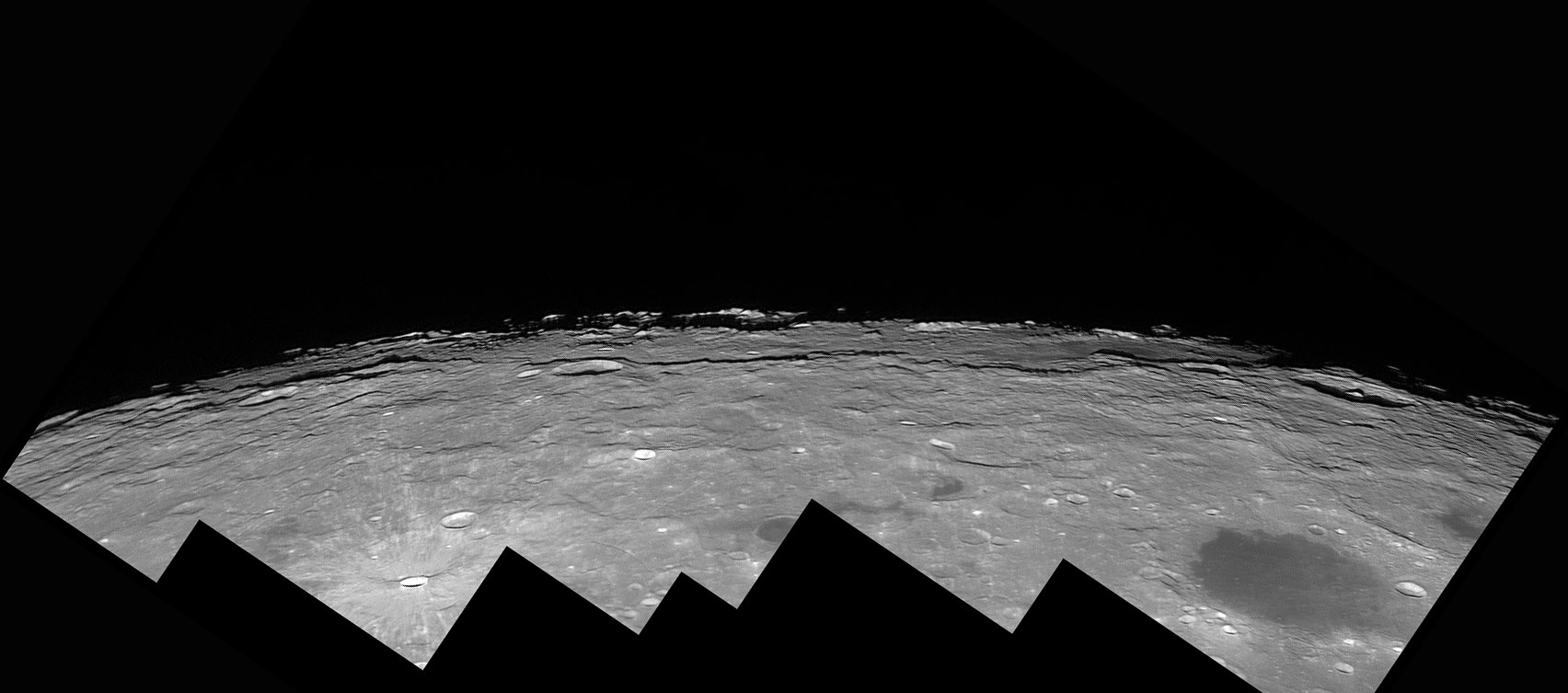|
|
| (6 intermediate revisions by the same user not shown) |
| Line 1: |
Line 1: |
| | __NOTOC__ | | __NOTOC__ |
| | =The Edge of a Bull's Eye= | | =The Edge of a Bull's Eye= |
| | + | <!-- Start of content --> |
| | <div class="post" id="post-908"> | | <div class="post" id="post-908"> |
| | | | |
| Line 6: |
Line 7: |
| | <p>[[File:Orientale_2006_04_13LPOD.jpg|orientale_2006_04_13LPOD.jpg]]</p> | | <p>[[File:Orientale_2006_04_13LPOD.jpg|orientale_2006_04_13LPOD.jpg]]</p> |
| | <p><em>image by [mailto:dpeach_78@yahoo.co.uk Damian Peach]</em></p> | | <p><em>image by [mailto:dpeach_78@yahoo.co.uk Damian Peach]</em></p> |
| − | <p>A circular mountain range looks nearly straight when seen edge on. Damian’s remarkable mosaic captures the Cordillera Mountains, the rim of the Orientale Basin on the Moon’s western limb. Visible here is a foreshortened perspective of about a third of the rim’s 930 km diameter. Because the Sun is shining from the east, only the edge of the shadow is visible - too little to suggest that the rim is 1.25 km high. Nearly on the limb to the right is a prominent linear mountain which is part of the Outer Rook Mountains, and near the center are illuminated peaks of the Inner Rook. Just inside the Cordilleras on the north (right) near the crater [http://www.lpod.org/archive/LPOD-2005-05-21.htm Schlüter] are the dark patches of Mare Autumni, lavas that leaked up the fault marked above surface by the Cordillera scarp. Between the Rook and the Cordillera is a flattish annular plain that isn’t basaltic (its not dark), and on Lunar Orbiter images is full of small knobs. This is considered to be ejecta (the Montes Rook Formation), demanding then that the dramatic Cordillera Mountains are not the true rim of the Orientale impact basin. In this interpretation, the much lower, disjointed Rook Mountains are the rim. And the Cordillera is a fault scarp created by masses of crust sliding down into the Rook depression. This is the standard view, but it always seems unlikely to me that the real rim would be so much smaller than the adjustment scarp!</p> | + | <p>A circular mountain range looks nearly straight when seen edge on. Damian’s remarkable mosaic captures the Cordillera Mountains, the rim of the Orientale Basin on the Moon’s western limb. Visible here is a foreshortened perspective of about a third of the rim’s 930 km diameter. Because the Sun is shining from the east, only the edge of the shadow is visible - too little to suggest that the rim is 1.25 km high. Nearly on the limb to the right is a prominent linear mountain which is part of the Outer Rook Mountains, and near the center are illuminated peaks of the Inner Rook. Just inside the Cordilleras on the north (right) near the crater [[May_21,_2005|Schlüter]] are the dark patches of Mare Autumni, lavas that leaked up the fault marked above surface by the Cordillera scarp. Between the Rook and the Cordillera is a flattish annular plain that isn’t basaltic (its not dark), and on Lunar Orbiter images is full of small knobs. This is considered to be ejecta (the Montes Rook Formation), demanding then that the dramatic Cordillera Mountains are not the true rim of the Orientale impact basin. In this interpretation, the much lower, disjointed Rook Mountains are the rim. And the Cordillera is a fault scarp created by masses of crust sliding down into the Rook depression. This is the standard view, but it always seems unlikely to me that the real rim would be so much smaller than the adjustment scarp!</p> |
| | <p>[mailto:tychocrater@yahoo.com Chuck Wood]</p> | | <p>[mailto:tychocrater@yahoo.com Chuck Wood]</p> |
| | <p><b>Technical Details:</b><br /> | | <p><b>Technical Details:</b><br /> |
| Line 12: |
Line 13: |
| | <p><b>Related Links:</b><br /> | | <p><b>Related Links:</b><br /> |
| | Rükl plate VII<br /> | | Rükl plate VII<br /> |
| − | [http://www.lpod.org/?m=20060719 Lunar Orbiter view]<br /> | + | [[July_19,_2006|Lunar Orbiter view]]<br /> |
| | [http://www.lpod.org/coppermine/displayimage.php?pid=346&fullsize=1 Clementine high Sun view]<br /> | | [http://www.lpod.org/coppermine/displayimage.php?pid=346&fullsize=1 Clementine high Sun view]<br /> |
| | [http://www.damianpeach.com/lunar.htm Damian’s website] </p> | | [http://www.damianpeach.com/lunar.htm Damian’s website] </p> |
| − | <p align="center"> | + | <p><b>Yesterday's LPOD:</b> [[February 1, 2007|Delayed Pleasure]] </p> |
| − | <i>You can support LPOD when you buy ANY book from Amazon thru [[LPOD]]</i></p> | + | <p><b>Tomorrow's LPOD:</b> [[February 3, 2007|A Control Network Topo Map]] </p> |
| | + | <!-- Removed reference to store page 2 --> |
| | </div> | | </div> |
| − | ---- | + | <!-- End of content --> |
| − | ===COMMENTS?===
| + | {{wiki/ArticleFooter}} |
| − | Click on this icon [[image:PostIcon.jpg]] at the upper right to post a comment.
| |




